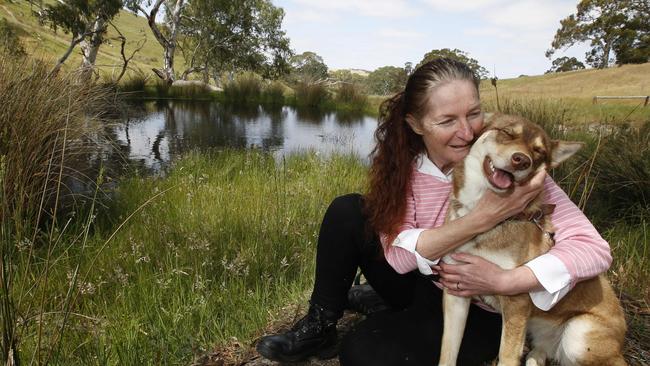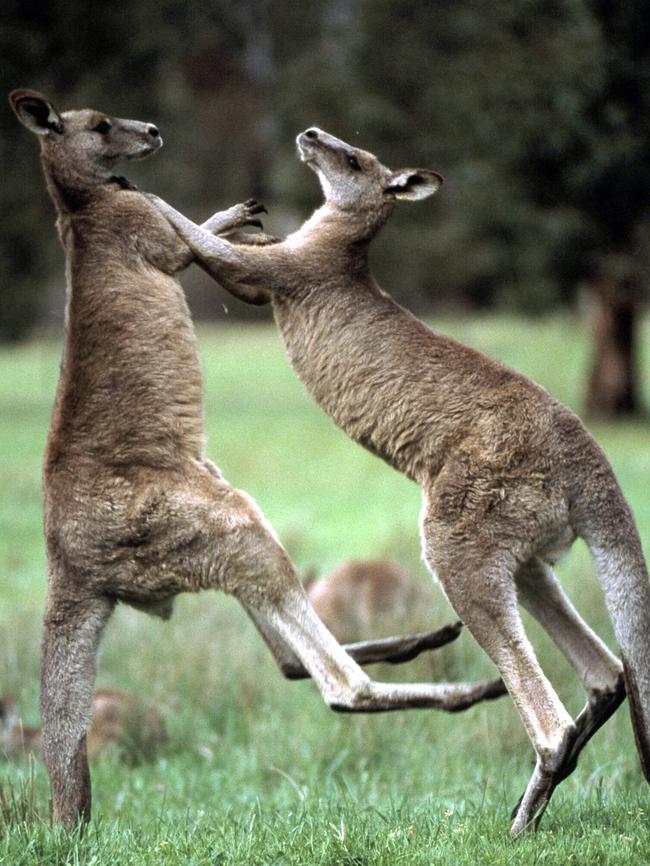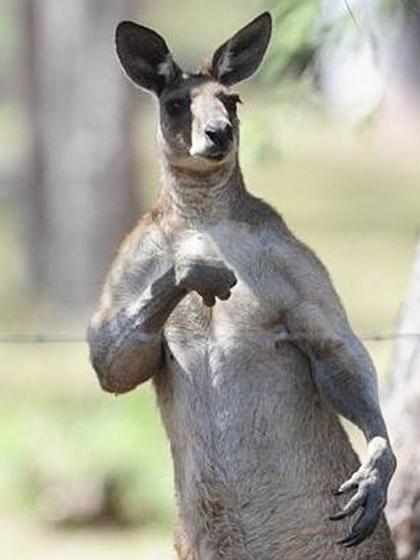I was nearly killed by a kangaroo: Adelaide Hills woman Margaret Acton shares her extraordinary story
MARGARET Acton remembers blows raining down on her body. Her towering attacker repeatedly struck and scratched her around the head and face, leaving horrific injuries. She was nearly killed by a kangaroo.

MARGARET Acton can still remember the blows raining down on her body.
Her towering attacker showed no hesitation as he struck and scratched violently at her head, face, upper body and legs dozens of times.
But Mrs Acton’s attacker wasn’t an intruder in her home. Astonishingly, it was a two-metre tall kangaroo that lives in scrubland on her Adelaide Hills property.
When the blows from the huge male marsupial finally stopped — only after her dog Jess intervened — Mrs Acton could feel the warm blood gushing down her face and neck as it flowed freely from shocking wounds that had opened up her scalp.
While her initial fear was rapidly succumbing to blood loss, minutes later her torn oesophagus would present another life-threatening problem as her throat began to swell and obstruct her airway.
After initial treatment from paramedics, Mrs Acton, 55, was rushed to the Royal Adelaide Hospital for emergency surgery. She would spend eight days there recovering — the first two in intensive care because of the severity of her injuries.
Mrs Acton, a 35-year police veteran, said the incident unfolded while taking Jess, a 16-month old husky/kelpie cross, for her usual walk late in the day on October 1.
The close-up encounter with the grey kangaroo was the first since she and her husband, Adrian, 75, moved to the property 15 years ago. While neighbours had occasionally seen large male kangaroos boxing one another and had one of their dogs attacked some time ago, the Actons had seen no unusual activity among the few kangaroos on their property.
Mrs Acton said the incident unfolded when she was approaching a dam. She saw two kangaroos bound away, but then lost sight of one. Jess had disappeared from view and Mrs Acton then heard a splash, thinking only that Jess had jumped in the dam for her usual swim.
As she approached the dam she then saw the huge kangaroo in the dam, with Jess in shallow water playfully approaching it. Each time Jess moved around the dam, the kangaroo would follow her.

Fearing Jess would be killed by the kangaroo if it reached her, Mrs Acton made the decision to intervene.
“I knew that kangaroos do entice dogs into dams and then drown them,’’ she said.
“It was just waiting for her to get back in the water each time and would follow her and she would get out again. I feared that if I left her he would get what he wanted.’’
Mrs Acton said when she moved closer to the edge of the dam she tripped, most likely on one of the many exposed gum tree roots on the bank, and stumbled into the shallow water.
Within seconds the kangaroo — 30cm taller than her — was upon her and inflicted the first blow with one of its paws. The blow struck her on the left side of the neck. Doctors believe this initial blunt force trauma was responsible for the internal injury that would later obstruct her airway.
Instinctively, Mrs Acton dropped to the soggy ground and went into the foetal position in order to protect her abdomen from any blows from the kangaroo’s powerful back legs.
“I curled myself up. I know what kangaroos do, I thought if I could curl up in a ball I could protect vulnerable parts of my body and he would go away and leave me alone,’’ she said.
“I thought I could lay still and play dead and he would go away.’’
While curled up she fumbled for her mobile telephone to call her husband, but she could not find which pocket it was in. She then attempted to slowly move toward a nearby fence, thinking she could crawl through it to safety.
“I knew it was barbed wire, but thought maybe I could get through it somehow and get away,’’ she said.
“As I got up, that’s when he attacked again. He was hitting and scratching at my head and body. He just kept at me. I thought I just had to get up and get away but as soon as I moved he would gouge me.
“I really didn’t think I was going to get away.’’

Mrs Acton said the attack only ended when Jess reappeared and started barking at the kangaroo.
“I thought this it, I wouldn’t see her again, I thought it would get her,’’ she said.
But thankfully, apparently scared by Jess’s barking, the attack ceased and Mrs Acton was able to get to her feet and she moved away from the dam. Bleeding profusely, she fumbled once again for her mobile, this time finding it and calling Mr Acton. The call lasted just seconds before it dropped out, but he could tell she was in trouble.
“I thought she may have trodden on a snake,’’ Mr Acton said.
“She didn’t get a chance to tell me what had happened, just that she needed help.’’
Mr Acton jumped in his utility and finally found her in a paddock adjacent the dam, which is about 900 metres from the house. He was shocked by what he encountered and quickly wrapped a towel around Mrs Acton’s head to try and stem the bleeding.
Perhaps because of her police training, Mrs Acton had remained calm and after calling her husband had dialled triple-0 for medical help. An ambulance officer was assisting her until that call too dropped out.
Once back at the house, Mr Acton lay Mrs Acton down on a bench seat on the porch. It was then she realised her neck muscles, throat and tongue were rapidly swelling and she was having trouble breathing.
“There is an internal tear. There is still a lump in my throat from the blow,’’ she said.
Thankfully, the first ambulance arrived shortly afterwards and managed to clear her airway. Paramedics then arrived and took over treatment. An initial plan to medivac her by rescue helicopter to the RAH was abandoned and paramedics continued treating her during the 40-minute road trip.
Once at the RAH, trauma surgeons were shocked at her injuries. She underwent immediate chest X-rays, a CAT scan and ultrasound to determine if she had any internal, head and chest injuries. Luckily, the tests revealed just the tear to her oesophagus.
All up, Mrs Acton had 15 staples inserted in her scalp to close the major wound, along with stitches to hold smaller cuts together, six stitches in a wound to her chin and multiple internal stitches to repair her right calf muscle.
Doctors at the RAH told her the attack is just the second they have recorded involving a kangaroo.
While her wounds will eventually heal, Mrs Acton said it will take her some time to once again enjoy tranquil walks with Jess on the property.
“I don’t feel as confident now, this has rattled me a little bit,’’ she said.
“I didn’t expect we had any kangaroos like that around here, I thought most were small and would just hop off. To know they will turn on you and do that, I had just heard stories like that.’’
She also felt her ordeal should serve as a warning for others who live on semi-rural properties to beware of kangaroos and interacting with them.
“People need to know they are not just cuddly animals. Just be wary, they can suddenly change. They are very quick and very powerful animals,’’ she said.
WHAT MAKES A KANGAROO ATTACK
KANGAROO attacks on humans are “extremely rare’’, according to wildlife experts.
Dr Deb Kelly, manager of animal welfare for the department for environment, water and natural resources, said such attacks were usually associated with feeding them in the wild.
She believed there had only been one fatal attack recorded, in Victoria several decades ago following an incident in which wild kangaroos were being fed at a highway rest stop.
While it was not the case in Margaret Acton’s attack, Dr Kelly warned people against feeding any wild animal because their behaviour changed once fed by humans.
“As soon as wildlife is fed it is not scared of people anymore,’’ she said.
“They will approach people more than they should.’’
Dr Kelly said a likely catalyst for the attack on Mrs Acton would have been the kangaroo’s fear of being attacked by her dog Jess.
“The fact the kangaroo was in the water means it is panicking and a panicking animal is not thinking straight,’’ she said.
“The kangaroo would have been associating the person with the dog and therefore views it as aggressive too.
“This is extremely rare. In most cases like this it is when wildlife has been fed.’’
She said property owners should use common sense and not approach wild animals and always carry a mobile telephone in case of more common incidents, such as a snakebite.
